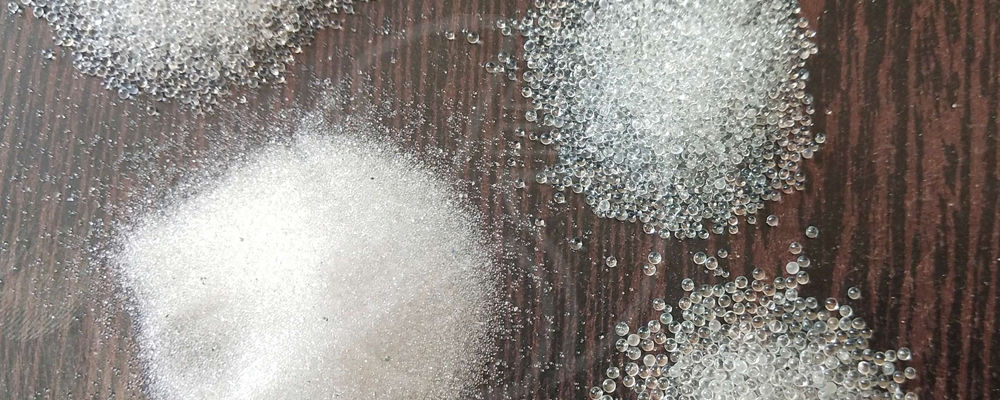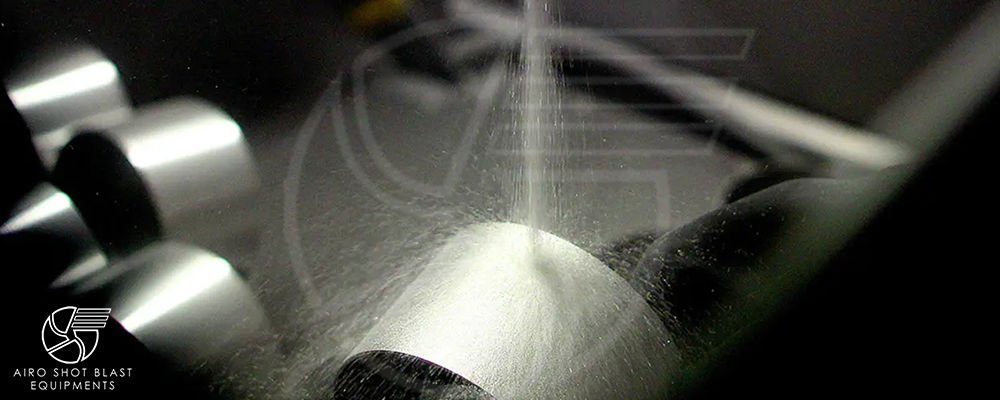What is Glass Bead Blasting & Its Role in Shot Blasting
Glass bead abrasive is a type of abrasive media that is made from small glass beads. These glass beads are typically spherical in shape and are available in a range of sizes, from very fine to coarse. They are used in a variety of industrial and commercial applications, such as surface finishing, cleaning, and peening.
In surface finishing, glass bead abrasive is often used to create a glossy or polished finish on a wide range of materials including metal, plastic, and wood. The beads are shot at the surface of the workpiece at high speeds, which causes them to collide and break down small surface imperfections. The result is a smooth and shiny surface. In cleaning, glass bead abrasive is used to remove surface contaminants, oil, rust, and paint from metal parts. It works by impacting the surface, removing unwanted materials, and leaving a clean surface. Glass beads are also used for the Peening process, Peening is a process that uses small shots or beads to impact the surface of a metal workpiece. The impact work hardens the surface, which improves the fatigue properties of the part.
Glass bead abrasive is considered a relatively safe abrasive compared to other abrasives because it is a non-toxic and non-polluting abrasive. It also will not create static electricity, which makes it suitable for use in explosive environments.
Glass Bead Blasting
Glass bead blasting is a process that uses small glass beads as the abrasive media to clean, smooth, or peen surfaces. The glass bead abrasive are propelled at high speeds onto the surface of the workpiece using compressed air or a centrifugal wheel. The impact of the beads on the surface removes contaminants, surface imperfections, and unwanted coatings while leaving a clean, smooth, and polished surface.
This process is commonly used in a variety of industries such as aerospace, automotive, and marine, for cleaning and finishing delicate or sensitive parts. Because glass beads are a soft and round abrasive, they will not damage the surface of the workpiece, making it an ideal method for delicate or thin materials.
The process can also be used for deburring, descaling, and surface preparation before applying coatings like paint or powder coating. The glass bead blasting process is considered safe to use, because the beads are made from non-toxic, non-polluting materials and will not create static electricity. Also, due to its round shape, it does not generate sharp edges, so there is less chance of causing damage to the operator or surrounding equipment.
It's also important to note that different sizes of glass beads could be used to adjust the level of aggressiveness of the process and make it suitable for different materials and surfaces.
Different Sizes of Glass Beads for Blasting
Glass beads used in abrasive blasting come in a range of sizes, each one suitable for different types of work and surfaces. The size of the beads is usually measured in terms of mesh size, which refers to the number of openings per linear inch in a sieve or screen through which the beads must pass.

Here are some examples of common glass bead sizes and their typical uses:
- 50-70 mesh: These are the largest beads and are often used for heavy-duty cleaning and the descaling of surfaces. They are also used for peening and surface preparation for coatings.
- 100-120 mesh: These medium-sized beads are well-suited for general cleaning and surface preparation. They are also used for descaling and deburring.
- 150-170 mesh: These glass bead abrasive are commonly used for light cleaning and surface finishing. They are also used for polishing and creating a glossy finish on a variety of materials.
- 220-240 mesh: These glass bead abrasive are the finest and are used for delicate cleaning and finishing. They are also used to create a very smooth surface on materials that are sensitive to damage.
It's important to note that the size of the beads will affect the aggressiveness of the blasting process, with larger beads being more aggressive and fine beads being less aggressive. The size of the beads also affects the surface finish, with larger beads leaving a more textured finish and smaller beads leaving a smoother finish. The right size of glass beads must be selected based on the surface material, and the desired finish.
Role of Glass Bead Abrasive in Shot Blasting Machine
In a shot blasting machine, glass bead abrasive is used as a blasting media to clean and smooth surfaces. The bead abrasive is propelled by compressed air or a centrifugal wheel onto the surface of the workpiece, which removes contaminants and surface imperfections. Glass bead abrasive is commonly used for cleaning and finishing delicate or sensitive parts, as well as for applications that require a glossy finish. Because it is a soft and round abrasive, it will not damage the surface of the workpiece, leaving a clean surface and a smooth finish.

Uses of Glass Bead Abrasive
Glass beads have a wide range of uses, both in industry and in everyday life. Here are a few examples of how glass beads are used:
- Abrasive blasting: As discussed before, glass beads are commonly used as the abrasive media in blasting equipment to clean, smooth, and peen surfaces. They are used to remove contaminants, surface imperfections, and unwanted coatings while leaving a clean and smooth surface.
- Sandblasting: Glass beads are used as a medium in sand blasting machine to etch designs or patterns on a variety of materials like glass, wood, and metal.
- Reflective road markings: Glass beads are used in reflective paint for road markings, as they reflect light back to the driver, increasing visibility at night or in poor weather conditions.
- Decorative filling: Glass beads are used to fill vases, candle holders, or other decorative objects to give them a unique look and feel.
- Jewelry-making: Glass beads are used to create a variety of jewelry items, from necklaces and bracelets to earrings and brooches.
- Artwork: Glass beads can be used to create artwork by gluing them to a canvas or board to make a mosaic or other decorative design.
- Sandblasting for teeth: Glass beads is also used as an abrasive for teeth sandblasting, it helps to remove plaque, stains, and other dental issues.
- Industrial Applications: Glass beads have been used as a filler and in many industrial applications, like refractory materials and glass-ceramic products.
As you can see, the uses of glass beads are quite diverse, and it's a versatile material that can be used in many different ways depending on the application and the desired result.
Glass Bead Price
The price of glass beads can vary widely depending on factors such as the size, shape, and quality of the beads, as well as the quantity that you're buying.
As a general reference, for abrasive blasting, the price per Kg for glass beads can range from around ₹70 - ₹110 per Kg. However, prices can be higher or lower depending on the quantity being purchased, and the specific characteristics of the beads.
In Airo Shot Blast Equipments, specialty glass beads that are made to a specific size or shape, or that have been treated to improve their performance, will typically be more expensive than standard glass beads. Also, purchasing in larger quantities usually comes with a bulk discount. Another factor we consider is the cost of delivery and handling, as this can add to the overall cost of the beads. As well as, at Airo Shot Blast Equipments we check the quality of the beads and make sure that they meet your specific needs before making a purchase.
